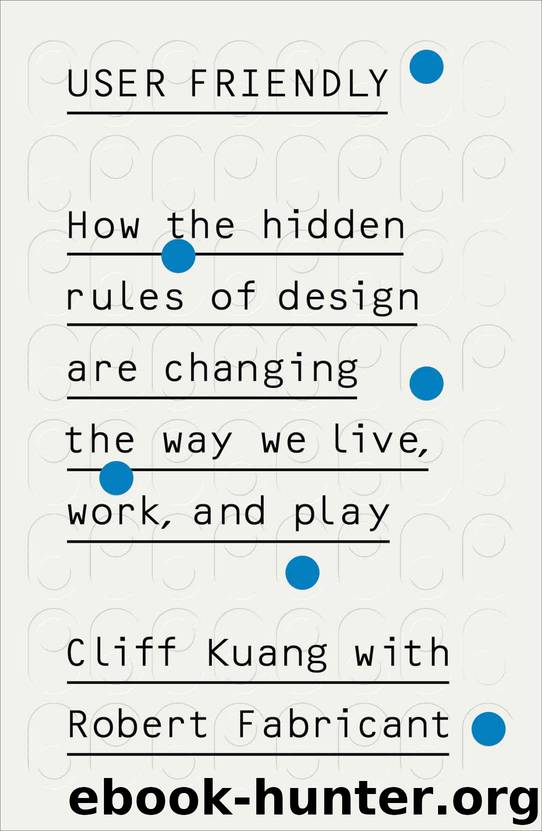User Friendly by Kuang Cliff & Fabricant Robert

Author:Kuang, Cliff & Fabricant, Robert [Kuang, Cliff]
Language: eng
Format: azw3
ISBN: 9780753551530
Publisher: Ebury Publishing
Published: 2019-11-06T16:00:00+00:00
Disney MagicBand (2013)
8
Personalization
Movies might seem like Disney’s core business, but they are really marketing vehicles. Most of the company’s billions come from turning movie hits into franchises: first with toys and TV shows, then with theme-park rides that imprint kids anew, powering sequels and selling more toys. Amusement parks are the flywheel in Disney’s cash machine. But by 2007 there were unmistakable signs that something was wrong in the Magic Kingdom. The numbers had started to turn, the most worrying being “intent to return.” Only half of new visitors to Disney World said that they’d come back, owing to lines and ticket costs. Thanks to a park running at twice the capacity that Walt Disney had planned for, there were lines everywhere, for rides and ice cream and bathrooms and food. Then there was the hassle of tracking tickets to the park and tickets to rides, and receipts and credit cards and maps and keys. Disney executives whispered to one another that the parks, once a bedrock of their quarterly results, might just be a “burning platform.” They worried, “If we miss out on that next generation of guests, suddenly our burning platform is fully on fire,” one of them told Fast Company’s Austin Carr. “Panic mode.”1
In 2008, Meg Crofton, who was then president of Disney Resorts, assembled her top deputies and told them to fix it. “We were looking for pain points,” she said. “What are the barriers to getting into the experience faster?”2 This notion of pain points was an intimation of the design-thinking process they were hoping to emulate, and the path they would follow next. They started by diagramming what a day at Disney World looked like for a typical family (a process called journey mapping in human-centered design). This was a cat’s cradle of crisscrossing paths: The day started when families would sprint from the opening gates to grab advance tickets for the most popular rides. Later, families would often split up, to make sure everyone could do what they wanted. They might cross in front of Cinderella’s castle twenty times a day. Looking at that map of what people went through was like putting a well-loved old couch on the curb: By the harsh light of day, you saw the stains you’d been living with for years and thought, I can’t believe we let it get like this. Not only that, the world was changing. By 2008, if you were a business executive with an eye toward coming disruptions, it was already clear that the year-old iPhone was poised to redefine expectations for convenience. What happened when the kids who’d grown up with the world on demand started contemplating where to take their kids on vacation? “On the surface, we had super happy guests, but in reality, we were making them go through so much hassle at the park that down the road, they would simply say, ‘No mas!’” said one former manager.3
John Padgett was part of the fix-it team flying back and forth between Disney headquarters in Burbank, California, and Walt Disney World, in Orlando, Florida.
Download
This site does not store any files on its server. We only index and link to content provided by other sites. Please contact the content providers to delete copyright contents if any and email us, we'll remove relevant links or contents immediately.
POP by Steven Heller(3327)
Japanese Design by Patricia J. Graham(3139)
The Power of Broke by Daymond John(2936)
Architecture 101 by Nicole Bridge(2782)
Indistractable: How to Control Your Attention and Choose Your Life by Nir Eyal(2360)
Fusion 360 for Makers by Lydia Sloan Cline(2336)
Batik by Rudolf Smend(2154)
Actionable Gamification: Beyond Points, Badges, and Leaderboards by Yu-kai Chou(2141)
Origami Art by Michael G. Lafosse & Richard L. Alexander(2081)
Homebody by Joanna Gaines(2049)
Whiskey in a Teacup by Reese Witherspoon(1957)
Worn in New York by Emily Spivack(1946)
Feng Shui by Stephen Skinner(1918)
Austin Kleon by Steal Like an Artist(1907)
Simple Gatherings by Melissa Michaels(1884)
Don't Make Me Think, Revisited: A Common Sense Approach to Web Usability by Steve Krug(1841)
Ryan Korban by Ryan Korban(1736)
Hygge: The Danish Art of Happiness by Marie Tourell Søderberg(1711)
The Joy of Hygge by Jonny Jackson(1706)
